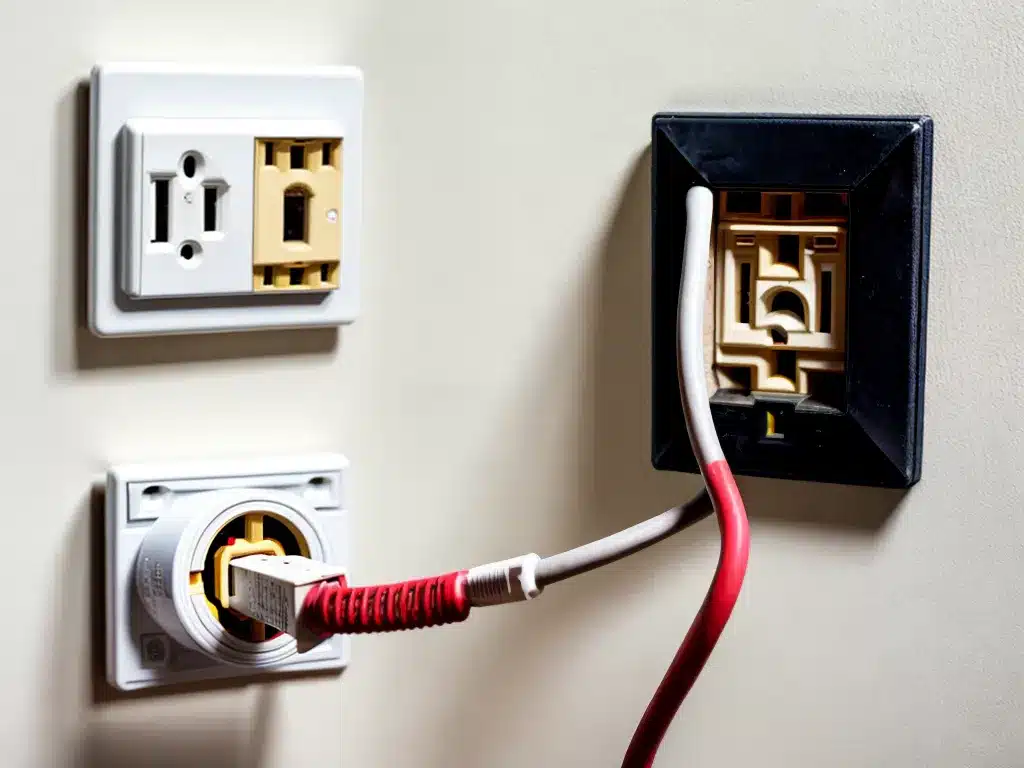
Electrical outlets are something we often take for granted in our homes. However, overlooked and unsafe use of power outlets can lead to severe injuries, fires, and even death. As a homeowner, it is crucial to understand the hazards posed by electrical outlets and how to use them safely.
The Shocking Dangers of Unsafe Outlets
One of the biggest risks with power outlets is the potential for electric shock. Inserting fingers or conductive materials into an outlet can result in a painful, dangerous jolt of electricity. Some factors that increase electric shock risks include:
-
Faulty wiring – Outdated or damaged wiring can allow electricity to flow unsafely through outlets. This greatly raises the chances of shock.
-
No grounding – Ungrounded outlets do not have a safe path for electricity to flow to the ground. This makes shocks more likely.
-
Moisture – Any moisture near an outlet can allow electricity to flow more freely, increasing shock risk.
-
Damaged cords – Frayed or cracked extension cords or chargers can expose live wires, allowing shocks to occur.
-
Overloaded outlets – Too many devices plugged into one outlet causes overheating, which can lead to fires or shocks.
Shocks from outlets can lead to severe burns and trauma. In worst cases, they can stop the heart and kill. Children are at highest risk as their small fingers fit easily into outlets.
Preventing Fires Started by Outlets
In addition to shocks, power outlets also pose a serious fire hazard if used improperly. The Consumer Product Safety Commission estimates over 43,000 fires originating from outlets each year. Some ways outlets start fires include:
-
Arcing – Loose plug connections can cause electrical arcing and sparks. This intense heat can ignite flammable objects.
-
Overloaded circuits – Drawing too much current through an outlet causes dangerous overheating of wires. This starts many outlet-related fires.
-
Combustibles nearby – Objects like towels or bags placed against outlets trap heat and can catch fire. Combustibles should be kept at least 3 feet away.
-
Rods inserted – Any metal objects like rods or keys inserted into outlets may touch live parts, create sparks, and start fires.
-
Damaged outlets – Cracked, warped, or broken outlets may expose wiring and create fire hazards.
Electrical fires are extremely dangerous as they can spread rapidly and produce toxic smoke. Preventing fires from unsafe outlet use is critical.
Protecting Children from Outlet Hazards
Protecting curious children from outlet dangers requires special precautions. Children often try inserting objects into outlets, which can have fatal consequences. Some ways to childproof outlets include:
-
Safety covers – Plastic covers block outlet holes when not in use. However, these are a choking hazard if removed and small enough for fingers to fit behind.
-
Safety plugs – Non-conductive dummy plugs prevent foreign objects from being inserted while still allowing adult access.
-
Guards – Sliding plastic guards flip down to cover outlets and prevent accidental contact. These work well but may not stop insertion of small objects.
-
GFCIs – Ground-fault circuit interrupters (GFCIs) monitor electricity flow and instantly cut power if an abnormal current such as a child’s finger is detected. However, they don’t physically prevent access.
-
Replacing outlets – New tamper-resistant outlets have a built-in shutter system to close off slots unless pressure is applied from both sides as when plugging in a cord. This prevents inserting objects.
Supervising young children and teaching them about outlet dangers are also essential for preventing accidents.
Inspecting and Maintaining Safe Outlets
The best defense against power outlet hazards is prevention through proper inspection and maintenance. Some key outlet safety tips include:
-
Hire an electrician for a whole-home inspection to check for aging wiring and ungrounded outlets. These should be upgraded for maximum safety.
-
Use GFCIs – Install ground-fault circuit interrupters anywhere outlets contact water. These will shut off power instantly if a current leak is detected.
-
Check for heat – Unplug devices and feel outlets for heat which may indicate overloading or loose connections.
-
Replace damaged – Promptly replace any outlets that are cracked, scorched, or show exposed wiring.
-
Keep free of clutter – Ensure nothing blocks access to outlets in case devices need urgent unplugging.
-
Consider AFCIs – Arc-fault circuit interrupters detect dangerous electrical arcing in wires and cut power to prevent fires.
-
Test frequently – Use an outlet tester every 6 months to check for safe wiring.
With vigilance and preventative safety measures, the overlooked dangers of electrical outlets can be avoided. Be proactive in inspecting and upgrading outlets, using high-quality cords and surge protectors, and teaching children safety. This will help prevent tragic accidents and keep homes safe.
